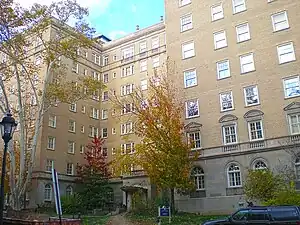Ruskin Hall | |
 Ruskin Hall at the University of Pittsburgh | |
| Coordinates | 40°26′48.83″N 79°57′10.63″W / 40.4468972°N 79.9529528°W |
|---|---|
| Built | 1923 |
| Architect | H. L. Stevens & Company |
| Part of | Schenley Farms Historic District (ID83002213) |
| Added to NRHP | July 22, 1983[1] |
Ruskin Hall is a residence hall at the University of Pittsburgh and a contributing property to the Schenley Farms National Historic District.[2] Constructed in 1921–22 by H. L. Stevens & Company, with an annex added in 1925–26,[3] it is an eight-story building which is located between the Music Building and Information Sciences Building between Ruskin and Bellefield Avenues near Fifth Avenue on Pitt's main campus in the Oakland neighborhood of Pittsburgh, Pennsylvania.[4] Ruskin Hall recently underwent a $19.4 million conversion and renovation from medical student housing into undergraduate apartment-style housing that opened in 2008.
History

Originally built in 1921–22 by H. L. Stevens & Company as the Ruskin Apartments, an annex facing Bellefield Avenue was added in 1925–26.[3] The building has long seen usage by Pitt students, including use as the meeting place of the Omega Delta fraternity until the fall of 1926. Pitt purchased the Ruskin Apartments in February 1958 for $2.24 million ($22.7 million in 2022 dollars[5]) as an investment, with the intention of using it eventually for faculty residences. Following the purchase, Pitt Chancellor Edward Litchfield held a tea for the 189 remaining tenants, many of whom were elderly, well-to-do widows, to ensure them that their leases and the staff and management would be maintained as long as they wished to stay.[6] With time, the apartments were relinquished giving Pitt full control of the building.
In 1966, Richard King Mellon donated $1,075,475 ($9.7 million in 2022 dollars[5]) to the university to refinance and retain possession of the Ruskin Apartments so they could be used for members of the house staffs of the university-affiliated hospitals and their families.[7]
Ruskin Hall has also served as the home for university offices including those of the University of Pittsburgh Press.[8] Through 2007, Ruskin Hall served as the primary residence for medical students and PhD candidates in the basic sciences of medicine, although students of other medical-related schools (including dental, nursing, and pharmacy) could be wait-listed for apartments.[4] Beginning in the summer of 2007, medical student housing was replaced by the Darragh Street Medical Student Housing complex, allowing for a $19.4 million renovation by Graves Design Group to convert Ruskin Hall into undergraduate apartment-style housing was completed for fall 2008.[9][10]
Facilities

Previously serving as a primary residence for medical students, Ruskin Hall contained 176 studio, efficiency, or one- to two-bedroom apartments each containing a living room, one to two bathrooms, and a kitchen. A ground floor study area, central courtyard, and laundry facilities were available and the building was outfitted with central air conditioning.[11]
A $19.4 million renovation was completed in 2008 that converted the Hall into an undergraduate residence hall with 178 apartment-style units with 416 beds[12][13] in one, two, and three-person apartments and single-person efficiency apartments. The furnished apartments include private baths and kitchens and have cable and internet connection. Commons areas are also equipped with wireless internet.[14] A University of Pittsburgh Police mini-station in Ruskin Hall was also part of the renovation.[15]
References
- ↑ "National Register Information System – (#83002213)". National Register of Historic Places. National Park Service. July 9, 2010.
- ↑
- 1 2 "Pitt Buying Ruskin Apts". Pittsburgh Post-Gazette. Pittsburgh, PA. February 28, 1958. p. 15. Retrieved January 28, 2009.
- 1 2 "University of Pittsburgh: Panther Central". www.pc.pitt.edu. Archived from the original on December 6, 2003.
- 1 2 1634–1699: McCusker, J. J. (1997). How Much Is That in Real Money? A Historical Price Index for Use as a Deflator of Money Values in the Economy of the United States: Addenda et Corrigenda (PDF). American Antiquarian Society. 1700–1799: McCusker, J. J. (1992). How Much Is That in Real Money? A Historical Price Index for Use as a Deflator of Money Values in the Economy of the United States (PDF). American Antiquarian Society. 1800–present: Federal Reserve Bank of Minneapolis. "Consumer Price Index (estimate) 1800–". Retrieved May 28, 2023.
- ↑ "Request Rejected".
- ↑ "Request Rejected".
- ↑ "Database Not Open". Archived from the original on September 30, 2011. Retrieved January 2, 2008.
- ↑ Schackner, Bill (April 11, 2006). "Pitt planning new residence halls". Pittsburgh Post-Gazette. Pittsburgh, PA. Retrieved October 20, 2009.
- ↑ "Ruskin Hall Dormitory Residential Building Design". Graves Design Group, LLC. Retrieved October 20, 2009.
- ↑ http://mac10.umc.pitt.edu/u/FMPro?-db=ustory&-format=d.html&-lay=a&-sortfield=issueid%3a%3aissuedate&-sortorder=descend&keywords=Ruskin%20Hall&-max=50&-recid=36451&-find=
- ↑ Hart, Peter (March 8, 2007). "Cathedral of Learning restoration project set". University Times. Vol. 39, no. 13. University of Pittsburgh. Retrieved October 20, 2009.
- ↑ Barlow, Kimberly K.; Hart, Peter (August 28, 2008). "What's New? Places". University Times. Vol. 41, no. 1. University of Pittsburgh. Archived from the original on June 16, 2010. Retrieved August 28, 2008.
- ↑ "Ruskin Hall". University of Pittsburgh. Retrieved October 20, 2009.
- ↑ "Database Not Open". Archived from the original on September 30, 2011. Retrieved January 2, 2008.
- Alberts, Robert C. (1987). Pitt: The Story of the University of Pittsburgh 1787–1987. Pittsburgh: University of Pittsburgh Press. ISBN 0-8229-1150-7.
